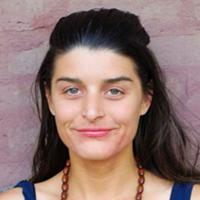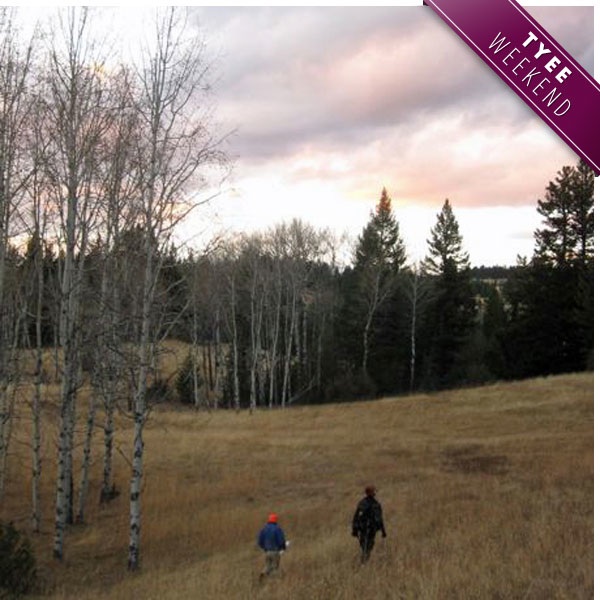My hunting instructor, Dylan, kneels down beside the body of a freshly-killed buck. "Now, there are only a few places on a deer's body where the guts are attached to the carcass," he says, as he moves the tail aside and traces a finger in a circle around the animal's anus. "This is one of them."
There's an uneasy silence from his students. There are nine of us altogether, standing in a semi-circle around this dead deer. I reach for my notebook to jot down this important point, as Dylan hands the knife to one of our more experienced members. Unlike most of us, Tom, who runs a small recycling business back in Vancouver, has been hunting before. He once went out with his girlfriend's very masculine Spanish father, who did most of the work. So, although the trip perhaps won him some brownie points, it didn't offer much hands-on experience. Now's his chance.
Tom gamely takes the blade and without hesitation -- as I struggle to maintain an expression of curious but clinical detachment -- cuts out the deer's asshole and pulls it, along with a few inches of rectum, out of the animal's body. With his bare hands.
"Some hunters use plastic gloves, or bring a bunch of paper towels that usually just get left in the field," Dylan pipes up. "I don't bother -- you can just wipe your hands on the grass!"
As Tom tugs on the rectum, little brown poop pellets spill out and onto the ground. It's a visceral reminder of how recently this young buck was alive, crapping and grazing his way across the grasslands of the B.C. Interior. He was standing here eating cloudberries, in fact, when Dylan shot him from roughly 80 yards away. He's about a year-and-a-half old; old enough to have short spiky antlers, but young enough to have still been with his family unit. "His mom and his sisters," says Dylan, a little bit wistfully. And then, more hopefully, "He's probably going to be a spectacular eating deer."
The meat provider
David Adams Richards, in his memoir Facing the Hunter, Reflections on a Misunderstood Way of Life, wrote, "My only suggestion to the world is that those who eat meat should be morally obligated to kill at least once in their lives that which they eat."
Food, after all, is why the ethical hunter hunts, and it is this sentiment that brought all of us here for Dylan's inaugural Eat Wild Hunting Workshop.
Dylan, 36, a park ranger who's been eating wild game since he could chew solid food and hunting since he was 12, started noticing something unusual in the past couple of years. He'd be at some house party in his eco-conscious East Vancouver neighbourhood and someone would inevitably pull him aside and whisper eagerly, enviously, "I hear you're a hunter."
Like canning, gardening and backyard chickening, hunting, it seems, is the latest old thing to become new again, fueled by an unease or even disgust with our industrial food system (which is even more disgusting, points out one of our members later, than gutting an animal with your bare hands).
Acutely aware of hunting's decline over the past two decades, Dylan saw not only a recruiting opportunity in the pool of eager, outdoorsy urban locavores in his midst, but also a way to open the door for a hunting revival. His business venture, Eat Wild, was born.
He tells me all this over the phone a week before the workshop. His venison sausages have converted at least two former vegetarian friends, he says, and he makes it clear (not that he wants to brag or anything), that he is an extremely successful hunter.
It's true, he's killed the kind of big game (eight-point bucks) that some hunters wait a lifetime for, but his greatest measure of success -- as far as he's concerned -- is his ability to maintain a seasonal supply of wild meat for himself, his friends and family. "Where I get my motivation and see my place in the world is as a hunter," he says. "I see my role in my little community as a provider of meat."
Down in Deadman Valley
The ranch is in Deadman Valley, not too far from the Centre of the Universe. It's 450 kilometres from Vancouver, and the last hour, down a windy, convoluted road that climbs up the valley and onto the Kukwaus Plateau, seems as long as the first four. Those who arrived late on Friday night were bleary-eyed from the drive, and those who arrived early on Friday evening were slightly more so from the wine we shared over dinner. Breakfast Saturday morning seemed like the first civilized introduction.
We had only just sat down and begun chatting over muffins and coffee when Dylan strides in, clad in full camo and a leather bullet belt about his waist. "I got one," he quietly announces.
(Later that night, drinking in the cabin's kitchen, Dylan's friend Mark remarks on what seemed like Dylan's incredible luck in shooting a deer right off the bat, the first morning of our workshop. "You have to be good to be lucky," says Mark, "but you also have to be lucky.")
But isn't luck in life simply about being in the right place at the right time? In hunting, that means being where the deer are. Dylan gives us pointers as we march out, bundled and half-asleep, into the cold morning air.
Look for the interface between open and closed, says Dylan. The kind of place where a grassy slope gives way to wooded hilltop. Deer are happiest in a spot where they have a view, an escape route, and food.
In the open areas, deer will bed down in tall timothy grass for the night, then rise at dawn to graze in patches of cloudberry and rosehip bushes. In darker wooded patches, they eat old man's beard, a black lichen that lives on tree branches. It does wonders for a deer's digestive system, and requires extremely clean air to grow well. Here, the fir and cedars are thick with it.
My gaze and thoughts are on the treeline in the distance when Dylan stops suddenly and points at a small piece of flagging tape hanging from the branch of a cloudberry bush.
"Over there," he says. This is another teaching moment: always flag your animal if you must leave and get help to drag it out, or else you'll have a hell of a time trying to find it again.
It dawns on me that this is real now, and for the first time I feel a flutter of nervousness in my stomach, a slight tightening of the throat. This is not just a walk in the woods, it's a mission to recover a dead body.
The deer is lying on its side, no visible blood except for a fine spray around its nostrils, with its tongue lolled out and the wide-open glassy eyes of an inanimate animal. It was a quick shot, a clean shot, says Dylan, which is the best a hunter can hope for. The worst is to hit an animal and not kill it -- the injured beast will crash into the bush and the hunter is obliged to go after it, a task not unlike that of a forensic investigator searching for evidence.
One time, Dylan tracked a deer by spotting and following a trail of tiny bits of chewed up rosehip stuck to leaves. The deer, he figured, had coughed them up as it struggled to breathe. Twenty minutes later, he found the animal, already dead. This is the responsibility of hunting, the burden of it. Every aspect of it, I'm realizing, takes time and care and patience.
Perhaps this is why fewer and fewer people bother. Hunting has experienced a steep decline in the past 25 years, and efforts to recruit new hunters have been so far unsuccessful. While some would no doubt rejoice at this news, wildlife conservation programs in the province depend on hunting license fees and taxes. The B.C. Habitat Conservation Trust Fund has funded $48 million worth of projects -- research, education and on-the-ground habitat restoration -- with hunting revenue since 1981. That year, there were 174,088 registered resident hunters in the province. Today, there are about half that many.
Why? For some, it's the hassle of gun licensing and hunting registration fees (the former is federal, the latter provincial), gas prices, lack of leisure time, and tough competition for that leisure time -- but particularly important, according to one survey commissioned by the BC Federation of Wildlife, is the loss of a hunting community. Like-minded people with whom you can hunt.
Primal
Dylan's hunting partner is Geoff, who is several decades older -- and wiser -- than his protégé.
Dylan knows deer, but Geoff really knows deer. He's hunted whitetail in the Kettle Valley for 25 years, and seen changes in their numbers and range, both increasing in British Columbia. He knows that mule deer are less "spooky" than whitetails; they don't necessarily take off if they spot a hunter. And if they do spook, nine times out of 10 they'll stop about a hundred yards out to glance back. That's when you have your gun ready.
Experience has taught Geoff to hunt in the early morning, and find an eastern facing slope to scope right around dawn. Chances are, says Geoff, you'll see one standing there facing the sun, "just soaking it up," he says, "like you or I would."
Geoff is waiting outside the cabin for us, coffee mug in hand, when we return with the gutted deer. He watches, a bemused look on his face as Eike, a photographer from Germany originally, enthusiastically clambers up a tree to secure a branch from which to hang the deer. Head up or head down, says Geoff, is a matter of personal tradition. His tradition is head down, and so we follow suit.
Our deer has been losing parts throughout the morning. First its blood and guts and organs were removed, and then its legs severed at the first joint so it could be strung up. Now it's time to remove what remains of the body -- the deer's protective skin and head. And it's my turn to take the knife.
Dylan shows me how to grip the loose fur with one hand, pulling it taut away from the flesh, and grip the knife with the other hand, gently scraping at the thin layer of white connective tissue. It's all muscle underneath, very little fat, and it dawns on me that I'm staring at protein in its very primal form.
Slowly, the deer becomes no longer a deer at all, but a piece of meat, of raw flesh. I think of the sun, the berries and the grass that went into making it.
I rest my palm for a second on the flesh, still very much warm. ![]()
















Tyee Commenting Guidelines
Comments that violate guidelines risk being deleted, and violations may result in a temporary or permanent user ban. Maintain the spirit of good conversation to stay in the discussion.
*Please note The Tyee is not a forum for spreading misinformation about COVID-19, denying its existence or minimizing its risk to public health.
Do:
Do not: